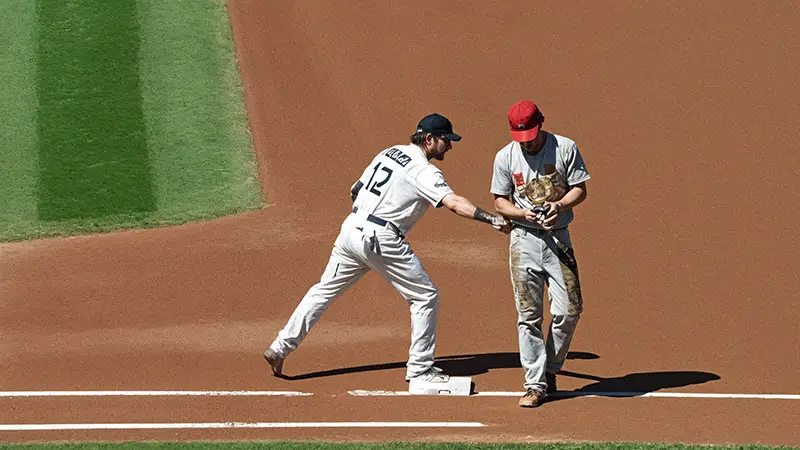Baseball’s hidden ball trick is a fascinating and cunning play that has intrigued fans for generations. Imagine the fielder slyly keeping the ball while pretending to return it to the pitcher, only to tag out an unsuspecting runner.
This clever deception requires precise timing and teamwork, making it a rare but thrilling spectacle. Understanding the rules behind the hidden ball trick is crucial for both players and fans.
The play hinges on specific conditions: the ball must remain in play without a timeout, and the pitcher must not be on the mound when the trick is executed.
These nuanced rules ensure that the hidden ball trick is as much about strategy as it is about skill. Dive into the intricacies of this unique play and discover what makes it one of baseball’s most captivating tactics.
The Hidden Ball Trick
The Hidden Ball Trick is a deceptive play in baseball where the fielding team attempts to trick the baserunner into believing the ball is not in play.
Here’s how it typically unfolds:
The Basics of the Trick
The hidden ball trick involves a fielder discretely keeping the ball to tag out a runner. Your typical setup sees this trick most effective when runners and fielders are repositioning.
To pull this off, the pitcher must avoid touching the pitching rubber, and the ball remains live. When conditions align, the fielder with the ball attempts to tag the runner unaware of the ball’s location.
Often, it’s performed after a time-out or when play resumes from a dead ball situation, making it a rare but thrilling spectacle.
Key to its success is the element of surprise and the coordination among the fielders. Though rare, when executed perfectly, it showcases strategic brilliance and adds an unexpected twist to the game.
Legal Perspectives in Baseball
In professional baseball, several rules govern the hidden ball trick. Rule 8.05(i) states that the pitcher cannot be on or astride the pitching rubber without the ball.
If this happens, it’s ruled a balk. Moreover, umpires must ensure play has resumed appropriately before the trick is executed.
On July 12, 2013, Everth Cabrera’s attempt against Pablo Sandoval demonstrated these rules’ enforcement. Since Sandoval had requested time, Cabrera’s tag was declared invalid.
These rules are in place to maintain fairness and regulate the deceptive nature of the hidden ball trick. Such plays, though rare, underscore baseball’s intricate rule set.
When correctly executed under these strict guidelines, the hidden ball trick remains an exciting element of the game.
Rules Across Different Leagues
Different baseball leagues, such as Major League Baseball (MLB), college baseball (NCAA), and high school baseball, generally follow similar rules but may have some variations.
Here are some key rules and potential differences across different leagues:
Major League Baseball (MLB)
In MLB, the hidden ball trick follows specific rules to maintain fairness. The pitcher must not stand on or near the pitching rubber without the ball.
If the pitcher engages the rubber without the ball, it results in a balk under Rule 8.05(i). Additionally, time must be called and play not resumed for the trick to be valid.
Umpires ensure that all these conditions are met to confirm the legality of such plays. Fielders involved in the hidden ball trick must maintain the illusion that the ball is in play.
Communication between players is crucial to execute this deceptive maneuver successfully. Effective execution often catches runners off guard, making it a rare but thrilling aspect of the game.
NCAA Regulations
NCAA regulations for the hidden ball trick generally align with professional rules. The pitcher cannot be on the mound without the ball, or it results in a balk.
Time must be called and resumed only after the pitcher takes their proper position. NCAA umpires are vigilant about these rules to keep the game fair and competitive.
Players, both fielders and pitchers, must understand these regulations to execute the trick effectively within legal boundaries. Awareness of these intricacies ensures smoother gameplay and reduces disputes.
High School and Little League Differences
High School and Little League incorporate variations in the hidden ball trick rules tailored for younger players.
In High School, the ball remains live unless declared dead by the umpire, but the same balk rule applies if the pitcher stands on the rubber without the ball.
Little League adds more preventive measures to ensure the safety and understanding of young athletes, often involving more explicit instructions from umpires regarding the status of the ball and play conditions.
Additionally, umpires in Little League may frequently halt play to clarify any confusion, especially regarding the ball’s location. These measures are designed to foster a safer and more educational environment.
Famous Instances of the Hidden Ball Trick
The Hidden Ball Trick is a rare and memorable play in baseball when successfully executed.
Here are some famous instances of the Hidden Ball Trick in baseball history:
Notable MLB Plays
In a game against the Boston Braves, Pee Wee Reese executed the Hidden Ball Trick on Tommy Holmes of the Braves.
Robinson pretended to throw the ball back to the pitcher, while Reese kept the ball hidden and tagged Holmes out.
Pee Wee Reese and Jackie Robinson (Brooklyn Dodgers, 1946)
In a game against the Boston Braves, Pee Wee Reese executed the Hidden Ball Trick on Tommy Holmes of the Braves. Robinson pretended to throw the ball back to the pitcher, while Reese kept the ball hidden and tagged Holmes out.
Mickey Mantle (New York Yankees, 1953)
Mickey Mantle, playing for the Yankees, successfully pulled off the Hidden Ball Trick against Gil McDougald of the Washington Senators. Mantle pretended to return the ball to the pitcher, tagging McDougald out when he stepped off the base.
Jim Gosger (New York Mets, 1969)
Jim Gosger of the New York Mets executed the Hidden Ball Trick against Hank Aaron of the Atlanta Braves. Gosger, playing outfield, pretended to throw the ball back to the infield but kept it hidden. When Aaron took a lead off second base, Gosger tagged him out.
Juan Uribe (Chicago White Sox, 2007)
Juan Uribe of the Chicago White Sox successfully executed the Hidden Ball Trick against Orlando Cabrera of the Los Angeles Angels. Cabrera had taken a lead off second base and was tagged out when Uribe revealed he still had the ball.
Rajai Davis (Toronto Blue Jays, 2010)
Rajai Davis, then playing for the Toronto Blue Jays, pulled off the Hidden Ball Trick against Howie Kendrick of the Los Angeles Angels. Davis pretended to return the ball to the pitcher, then tagged Kendrick out when he stepped off first base.
Impact on Game Outcomes
The hidden ball trick’s success or failure can significantly impact game outcomes. In close games, such as those with tied or one-run differences, successfully executing the trick can shift momentum.
An example occurred when John Heisman employed the hidden ball trick to score Auburn’s only touchdown in a close 6-9 loss to Vanderbilt in 1895. Though an old instance, it underscores the impact a single play can have.
In another example, discrepancies between umpires’ perceptions led to controversy. In a game scenario where the base umpire declared a runner out based on timing but met disagreement from the home crowd, the hidden ball trick emphasized the challenge in consistently enforcing rules.
While such instances tend to stir debate, they also underline the skill and quick thinking required to execute this play effectively.
Strategies Behind the Hidden Ball Trick
The Hidden Ball Trick in baseball is not just about deception; it also requires strategic timing and execution.
Here are the key strategies behind the Hidden Ball Trick:
When Teams Typically Use It
Teams typically use the hidden ball trick in high-pressure situations to catch the opposing team off guard. It often occurs when a runner is on base, specifically first or third, and there’s a significant game moment.
For example, teams might attempt this trick after a mound visit or between pitches when the ball isn’t in play. Successful execution requires precise timing and cooperation between infielders.
In particular, third baseman Bill Coughlin was reputed to have mastered this tactic, pulling it off multiple times to achieve crucial outs.
Psychological Impact on Opposing Players
The hidden ball trick leverages surprise, creating a psychological impact on opposing players. When a player falls for the trick, it can disrupt their focus and morale.
It demonstrates the defensive team’s cunning and readiness, often leading to hesitation and wariness among base runners.
For example, Everth Cabrera’s attempt to perform the hidden ball trick on Pablo Sandoval, although unsuccessful, showcased how such efforts can influence the dynamics of a game.
Opponents may become more cautious, altering their strategies and diminishing their aggressiveness on bases.
This tactical maneuver reinforces the importance of constant vigilance and can shift the momentum in favor of the defensive team.
Frequently Asked Questions
What is the hidden ball trick in baseball?
The hidden ball trick is a deceptive play where an infielder pretends to return the ball to the pitcher but secretly keeps it hidden. When the runner steps off the base, the infielder tags them out. This tactic is rare and requires perfect timing and cooperation among players.
When is the hidden ball trick typically used?
Teams usually employ the hidden ball trick during high-pressure situations, such as when a runner is on first or third base. It’s often used to catch opponents off guard during significant moments in the game.
Which players are known for mastering the hidden ball trick?
Bill Coughlin is notably recognized for mastering the hidden ball trick. Skilled players need precise timing and seamless cooperation with teammates to successfully execute this play.
How does the hidden ball trick impact opposing players psychologically?
Falling for the hidden ball trick can disrupt a player’s focus and morale, causing them to hesitate and rethink their strategies. It can shift the momentum in favor of the defensive team.
Conclusion
Understanding the hidden ball trick in baseball adds a fascinating layer to your appreciation of the game. This clever tactic, steeped in strategy and precision, can dramatically shift the momentum in favor of the defensive team.
By staying alert and aware of the potential for such tricks, you can better appreciate the intricate details that make baseball so captivating.
Whether you’re a player aiming to master this skill or a fan eager to spot it in action, the hidden ball trick remains a testament to the sport’s enduring complexity and excitement.
Knowing the specific rules surrounding the hidden ball trick is crucial. For instance, the pitcher cannot be on the pitching rubber during the trick, and time must be in play. Understanding these nuances ensures a deeper grasp of this unique aspect of baseball.








Pat Bloom